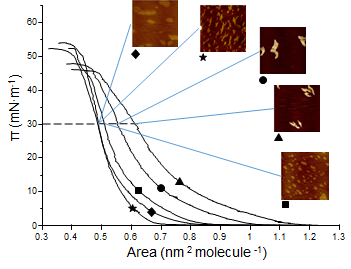Effect of cholesterol on monolayer structure of different acyl chained phospholipids
In this work we have investigated the effect of cholesterol (CHOL) in phospholipid monolayers on a series of phosphatidylcholines differing in acyl chain composition. We have used the CHOL proportion that abolishes the gel (Lβ)-to-liquid-crystalline (Lβ) transition in bilayers in order to investigate the mixing properties and laterally-segregated domains formed by specific phospholipid-CHOL ratios at the air-water interface. The binary monolayers where formed by mixing CHOL with 1,2-palmitoyl-sn-glycero-3-phos-phatidylcholine (DPPC);1,2-distearoyl-sn-glycero-3-phosphatidylcholine (DSPC); 1-pal-mitoyl-2-stearoyl-sn-glycero-3-phosphatidylcholine (PSPC); 1-palmitoyl-2-oleoyl-sn-gly-cero-3-phosphatidylcholine (POPC) and 1-palmitoyl-2-linoleyl-sn-glycero-3-phosphatidyl-choline (PLPC), respectively. From surface pressure-area (π–A) isotherms the isothermal compression modulus were calculated, and the mixing properties of the monolayers obtained by performing a basic surface thermodynamic analysis. From the excess Gibbs energy, the interaction parameter and the activity coefficients were also calculated. The study of the monolayers was complemented by determining the molecular dipole moment normal to the plane of the monolayer. The existence of laterally segregated domains was assessed by atomic force microscopy (AFM) of Langmuir-Blodgett films (LBs) extracted at 30 mNm−1. To get insight into the nature and composition of the observed domains force spectroscopy (FS) based on AFM was applied to the LBs.
https://doi.org/10.1016/j.colsurfb.2018.11.040



